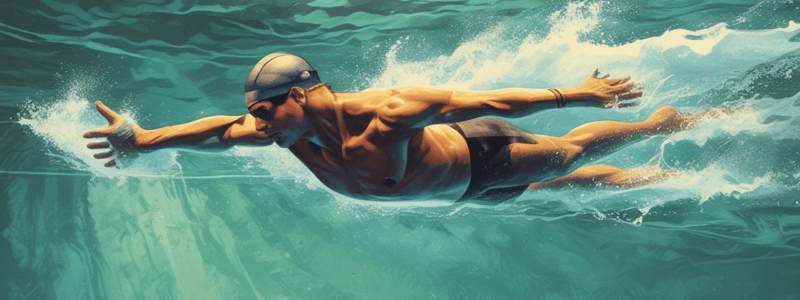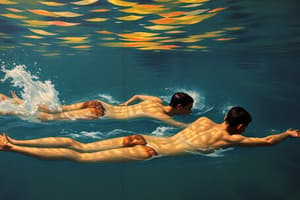Podcast
Questions and Answers
What was the primary reason for swimming in primitive societies?
What was the primary reason for swimming in primitive societies?
- For recreation and pleasure
- For hygienic purposes only
- For military training
- For survival and finding food (correct)
In which civilization did swimming become a part of military training?
In which civilization did swimming become a part of military training?
- Ancient Greece and Rome (correct)
- Primitive Societies
- Ancient Egypt
- Ancient Pakistani city of Mohenjo-daro
What was the 'Great Bath' in Mohenjo-daro used for?
What was the 'Great Bath' in Mohenjo-daro used for?
- Hygienic purposes
- Military training
- Public swimming
- Ritual bathing and religious ceremonies (correct)
What was discovered in Egypt in 1993 that showed swimming in history?
What was discovered in Egypt in 1993 that showed swimming in history?
Why did people fear swimming during the Dark Ages?
Why did people fear swimming during the Dark Ages?
When did people start swimming for recreational purposes?
When did people start swimming for recreational purposes?
What was the approximate year when the first public water tank was built?
What was the approximate year when the first public water tank was built?
When were the first recreational pools built?
When were the first recreational pools built?
Who was the first to create recreational swimming pools?
Who was the first to create recreational swimming pools?
What feature did the Ancient Romans add to their pools and baths?
What feature did the Ancient Romans add to their pools and baths?
What was the purpose of the 'Palaestrae' in Ancient Greece?
What was the purpose of the 'Palaestrae' in Ancient Greece?
Where was the first heated swimming pool built?
Where was the first heated swimming pool built?
When did the first public indoor municipal swimming pool open in England?
When did the first public indoor municipal swimming pool open in England?
What was the name of the first indoor pool in the history of swimming?
What was the name of the first indoor pool in the history of swimming?
When did swimming pools become popular?
When did swimming pools become popular?
Where was the first swimming pool in the U.S.?
Where was the first swimming pool in the U.S.?
Who swam across the English Channel in 21 hours and 45 minutes?
Who swam across the English Channel in 21 hours and 45 minutes?
What was the purpose of Aquae Sulis?
What was the purpose of Aquae Sulis?
Who introduced swimming as a competitive sport in the Philippines?
Who introduced swimming as a competitive sport in the Philippines?
Where was the first swimming pool in the Philippines constructed?
Where was the first swimming pool in the Philippines constructed?
What year did the Filipinos participate in the second championship meet?
What year did the Filipinos participate in the second championship meet?
Who is considered the greatest Filipino swimmer for his feats in national championship meets, the Far East and Olympic Games?
Who is considered the greatest Filipino swimmer for his feats in national championship meets, the Far East and Olympic Games?
Who formulated and implemented his own style of teaching swimming in 1956?
Who formulated and implemented his own style of teaching swimming in 1956?
What material allowed for faster installation, more flexible designs, and lower costs than previous methods in the pool business?
What material allowed for faster installation, more flexible designs, and lower costs than previous methods in the pool business?
When did above ground pool kits hit the market?
When did above ground pool kits hit the market?
What is one of the benefits of recreational swimming?
What is one of the benefits of recreational swimming?
What is one of the common swimming styles in recreational swimming?
What is one of the common swimming styles in recreational swimming?
What year did the Philippines achieve its best performance in the Southeast Asean Games (SEAGAMES)?
What year did the Philippines achieve its best performance in the Southeast Asean Games (SEAGAMES)?
What is a key aspect of forming friendships in a swimming team?
What is a key aspect of forming friendships in a swimming team?
What is a key benefit of setting goals in swimming?
What is a key benefit of setting goals in swimming?
What is a key aspect of gender equity in swimming?
What is a key aspect of gender equity in swimming?
What is a key lesson learned from having a support team in swimming?
What is a key lesson learned from having a support team in swimming?
What is a key aspect of courage in swimming?
What is a key aspect of courage in swimming?
What is a key aspect of compassion in swimming?
What is a key aspect of compassion in swimming?
What was the swimming style used by Captain Boyton to swim from Linz to Budapest in 1876?
What was the swimming style used by Captain Boyton to swim from Linz to Budapest in 1876?
What was the main purpose of the developments in science and technology in the 20th century for swimming pools?
What was the main purpose of the developments in science and technology in the 20th century for swimming pools?
Who won the first gold medal in the 100 m freestyle at the Olympic Games in 1896?
Who won the first gold medal in the 100 m freestyle at the Olympic Games in 1896?
What was the restriction on women's swimwear at the early Olympic Games?
What was the restriction on women's swimwear at the early Olympic Games?
Who was the first woman to swim the English Channel in 1926?
Who was the first woman to swim the English Channel in 1926?
What was the innovation introduced at the 1924 Olympic Games?
What was the innovation introduced at the 1924 Olympic Games?
Who won seven gold medals in Munich in 1972?
Who won seven gold medals in Munich in 1972?
Who holds the record for the most gold medals won at a single Olympics?
Who holds the record for the most gold medals won at a single Olympics?
What was the achievement of Tamás Darnyi in 1991?
What was the achievement of Tamás Darnyi in 1991?
Who is considered the most successful Olympic champion of all time?
Who is considered the most successful Olympic champion of all time?
What is the main objective of a swimmer in competitive swimming?
What is the main objective of a swimmer in competitive swimming?
What is a benefit of swimming for people with osteoarthritis?
What is a benefit of swimming for people with osteoarthritis?
Which of the following values is gained from swimming?
Which of the following values is gained from swimming?
What is a key lesson learned from competitive swimming?
What is a key lesson learned from competitive swimming?
What is a benefit of swimming for older adults?
What is a benefit of swimming for older adults?
What is a key aspect of swimming that requires discipline?
What is a key aspect of swimming that requires discipline?
What is a benefit of swimming for people with fibromyalgia?
What is a benefit of swimming for people with fibromyalgia?
What is a value gained from swimming that is essential for success in life?
What is a value gained from swimming that is essential for success in life?
What is a benefit of swimming for post-menopausal women?
What is a benefit of swimming for post-menopausal women?
What is a key aspect of swimming that requires attention to detail?
What is a key aspect of swimming that requires attention to detail?
Flashcards are hidden until you start studying
Study Notes
Background of Swimming and Aquatics
- Swimming is an ancient activity that has been taking place since the existence of humans and water on earth.
- Prehistoric drawings from Egypt show people swimming, possibly using the dog paddle or breaststroke.
- Swimming was necessary for survival in primitive societies.
- In ancient Greece and Rome, swimming was practiced by warriors as part of their military training.
- During the Dark Ages, swimming was feared due to the belief that outdoor bathing or water practices could spread diseases.
- In the time of Henry II of Great Britain, young people learned to swim as a recreational activity.
Historical Timeline of Swimming
- 5000 B.C.: The Great Bath, a public water tank, was built in Mohenjo-daro, Pakistan, for religious ceremonies and ritual bathing.
- 2500 B.C.: Cave paintings in Egypt depicted figures swimming.
- 800 B.C. to 600 B.C.: The Ancient Greeks built recreational swimming pools in open-air gymnasiums called Palaestrae.
- 300 B.C. to 100 B.C.: The Ancient Romans built luxurious pools and baths, including the first heated swimming pool.
- 75 A.D.: The Romans built Aquae Sulis, a religious spa in Britain, with thermal springs.
- 1586-1611 A.D.: Swimming became a competitive event in Japan, with the first tournaments held in 1810.
- 1820s: The first indoor swimming pool opened to the public in England.
- 1837: Six indoor pools with diving boards were built in London, England.
- 1862: The first indoor pool was constructed in England.
- 1868: The first swimming pool in the United States, the Cabot Street Bath, was opened in Boston.
- 1875: Matthew Webb swam across the English Channel in 21 hours and 45 minutes.
- 1876: Captain Boyton swam from Linz to Budapest using a sail and oars.
- 1880: The Amateur Swimming Association of Great Britain was established.
- 1896: Swimming became an Olympic sport at the Athens Olympics.
Olympic Games and Swimming
- 1896: The first Olympic Games featured swimming as a men's sport in open water.
- 1900: The second Olympic Games in Paris added more events, including breaststroke and backstroke.
- 1912: Ladies were allowed to participate in the Olympics, but only in the 100-meter freestyle and 4x100-meter relay events.
- 1924: The 50-meter-long pool was used in Paris, and the backstroke style was allowed for women.
- 1972: Mark Spitz won 7 gold medals in Munich.
- 1980s: Tamás Darnyi was a four-time Olympic champion in medley.
- 2004: Michael Phelps won 8 medals, including 6 gold medals, in Athens.
- 2008: Michael Phelps won 8 gold medals in Beijing.
Historical Background of Swimming in the Philippines
- 1907: The first swimming pool in the Philippines was constructed at Fort Mckinley YMCA.
- 1910: The first dual swimming meet was held between Manila YMCA and Fort Mckinley YMCA.
- 1911: The first swimming championship meet was held at the American Columbian Club swimming pool.
- 1912: Filipinos participated in the second championship meet.
- 1913: The Philippine Team won the championship against China and Japan at the Far Eastern Games.
- 1924: Teofilo Yldefonso, a Philippine Scout soldier, won recognition as the greatest Filipino swimmer.
Nature of Swimming
- Swimming for recreation: a low-impact workout and a way to relax and feel good.
- Competitive swimming: a vigorous workout and a fun and thrilling competition.
- Health benefits of swimming:
- Improved cardiovascular fitness
- Improved muscular strength and endurance
- Improved flexibility
- Improved quality of life
- Reduced risk of chronic disease and death
- Improved joint mobility and reduction in pain
- Mediates symptoms of rheumatoid arthritis
- Improves mental health
- Decreases anxiety and depression
- Improves the health of mothers and their unborn children
- Improves and maintains bone health of post-menopausal women
- Older adults: improves quality of life, decreases disability, improves balance
Values Gained from Swimming
- Fitness
- Self-Confidence
- Discipline
- Teamwork
- Sportsmanship
- Work Ethic
- Delayed Gratification
- Time Management
- Dedication
- Skill Improvement
- Friendship and Respect
- Goal Setting
- Gender Equity
- Appreciation of your support team
- Courage
- Compassion
Studying That Suits You
Use AI to generate personalized quizzes and flashcards to suit your learning preferences.




